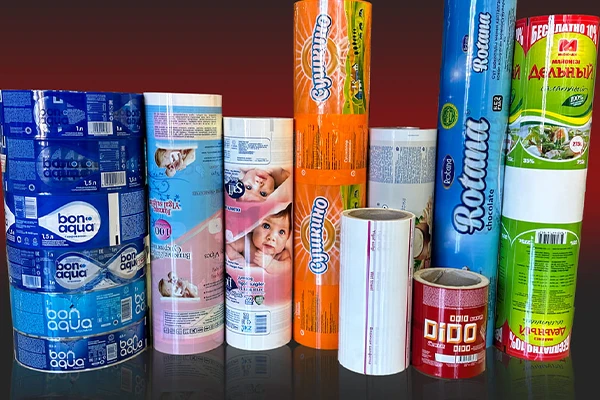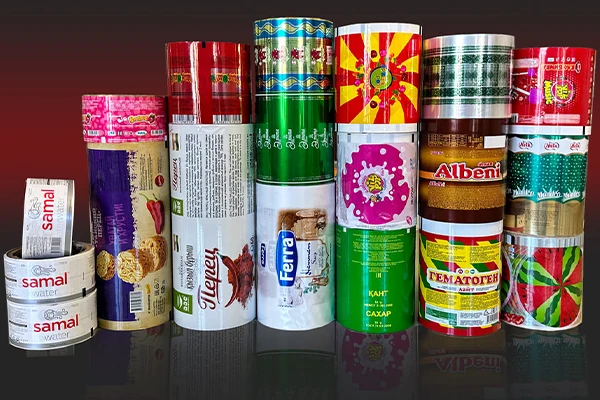What Is Composite Packaging Material?
Composite packaging materials are packaging materials composed of two or more materials combined through a lamination process. Generally, they can be divided into the base layer, functional layer, and heat-sealing layer.
- Base layer materials: BOPP, BOPET, BOPA, MT, KOP, KPET, etc., have the functions of aesthetics, printing, and moisture resistance.
- Functional layer materials: VMPET, AL, EVOH, PVDC, etc., have the functions of barrier and light protection.
- Heat-sealing layer materials: CPP, VMCPP, EAA, EMAA, etc., which have the functions of permeation resistance, heat sealing, and transparency.

Composite Packaging Material Types
Composite packaging materials can be divided into paper/poly laminated materials, AL/poly laminated materials, paper/AL/polyeater laminated materials, paper/paper laminated materials, plastic/poly composite laminated materials, etc.
- Paper/plastic composite materials can be divided into paper/PE, paper/PET, paper/PS, paper/PP, etc. according to materials.
- Aluminum/plastic composite materials can be divided into AL/PE, AL/PET, AL/PP, etc. according to materials.
- Paper/aluminum/plastic composite materials can be divided into paper/AL/PE, paper/PE/AL/PE, etc. according to materials.
Common Composite Packaging Materials Introduction
| 缩写 | Full Name |
| AL | 铝箔 |
| BOPA(NY) | Biaxially oriented polyamide film |
| BOPET(PET) | Biaxially oriented polyester film |
| BOPP | Biaxially oriented polypropylene film |
| CPP | Cast polypropylene film |
| EAA | Ethylene-acrylic acid plastic |
| EEAK | Ethylene-ethyl acrylate plastic |
| EMA | Ethylene-methacrylic acid plastic |
| EVAC | Ethylene-vinyl acetate plastic |
| PE | Polyethylene |
| PA | Nylon film |
| PO | Polyolefin |
| PT | Cellophane |
| VMCPP | Vacuum aluminum-coated cast polypropylene |
| VMPET | Vacuum aluminum-coated polyester |

BOPP is a film made of polypropylene as the main raw material and made by biaxial stretching using the flat film method. It has high tensile strength, high rigidity, good transparency, good gloss, low static performance, excellent printing performance and coating adhesion, and excellent water vapor and barrier properties, so it is widely used in various packaging industries.
PE is a thermoplastic resin obtained by polymerization of ethylene. PE is odorless, non-toxic, feels like wax, has excellent low temperature resistance (the lowest operating temperature can reach -100~-70°C), good chemical stability, can withstand the corrosion of most acids and alkalis, has low water absorption, and has excellent electrical insulation.
CPP is also called unstretched polypropylene film. CPP can be divided into GCPP, MCPP, and RCPP according to different uses.
VMPET is mainly used as a protective film for dry and puffed food packaging and for the outer packaging of medicines and cosmetics. Aluminized film has both the characteristics of plastic film and metal. The function of aluminizing the film surface is to block light and prevent ultraviolet radiation, which not only prolongs the shelf life but also improves the surface brightness. It replaces aluminum foil to a certain extent and is also cheap, beautiful, and has good barrier properties. Therefore, aluminized film is widely used in composite packaging.
PET has excellent physical and chemical properties, dimensional stability, transparency, and recyclability.
- Thickness: 38μm~250μm
- Width: 500-1080mm
- Out Diameter: 300mm~650mm
- Inner Diameter: 76mm (3〞)、152mm (6〞)
PA is a very tough film with good transparency, good gloss, tensile strength, good heat resistance, cold resistance, oil resistance, wear resistance, and puncture resistance. It is relatively soft and has excellent oxygen barrier properties, but it is easy to absorb moisture and has poor heat-sealing properties. It is suitable for packaging hard items, such as greasy food, meat products, fried food, vacuum-packed food, steamed food, etc.
Composite Laminated Ways
There are 5 types of composite lamination methods: dry lamination, solvent-free lamination, wet lamination, extrusion lamination, and co-extrusion lamination.
1. Dry Lamination
Dry lamination is the most common lamination technology, which mainly combines two or more substrates together, then applies an adhesive to one substrate, and then heats it to volatilize the solvent, leaving a dry adhesive layer. After that, the other substrate is bonded to it under hot pressing conditions. This technology is suitable for aluminum polyester laminates.
2. Solventless Lamination
Solventless lamination is a technology developed in recent years under the environmental protection trend. It uses solvent-free adhesives to bond substrates, avoiding the use of solvents, thereby reducing VOC emissions. This method is not only environmentally friendly but also more efficient in the use of adhesives and is often used in applications with high safety requirements, such as food packaging.
3. Wet Lamination
Wet lamination is similar to dry lamination, but the adhesive is not dried before lamination. Instead, the materials are bonded while the adhesive is still wet and then cured by heating or natural drying. This method is suitable for occasions where the initial adhesion of the adhesive is not high, the operation is relatively simple, and the cost is low.
4. Extrusion Lamination
Extrusion lamination uses an extruder to extrude hot-melt resin from a die head onto a substrate and bond it to another substrate under a certain pressure. This technology is suitable for packaging materials that require an additional layer of protection, such as moisture-proof and oil-proof properties. Extrusion lamination provides excellent bonding strength and durability and is widely used in food packaging and industrial materials.
5. Coextrusion lamination
Coextrusion lamination is an advanced form of extrusion lamination, involving multiple different materials being extruded simultaneously through a coextrusion die to form a multi-layer composite structure. This method can combine the advantages of multiple materials in one process to achieve specific performance requirements, such as barrier properties, mechanical strength, and appearance effects. Coextrusion lamination has a wide range of applications in food and pharmaceutical packaging.
AL/Poly Composite Packaging Materials
| 类型 | Composition |
| I | BOPA/AL/PE, BOPA/AL/CPP, BOPA/PE/AL/CPP, BOPA/AL |
| II | BOPA/AL/PE, BOPA/AL/CPP, BOPA/ PET/AL/CPP, BOPA/AL |
| III | BOPP/AL/PE, BOPP/AL/CPP, BOPP/AL |
| IV | PT/AL/PE, PT/AL/CPP, PT/AL/BOPA/PE, PT/AL/PET/PE, PT/ALPO/AL/PE, PO/AL/CPP, PO/AL/BOPA/PE, PO/AL/PET/PE, PO/AI |
| Note: PO in Class IV is a coating or unstretched film. | |
| Material Composition | 应用 |
| OPP/PE | For lightweight solid packaging |
| OPP/CPP | |
| OPP/VMPET/PE | |
| OPP/VMPET/CPP |
| Material Composition | 应用 |
| PET/AL/PE | For lightweight wet goods (moisture-proof) packaging |
| PET/VMPET/PE | |
| PET/PE | |
| PET/CPP | |
| PET/AL/CPP |
| Material Composition | 应用 |
| CPP/PE | Applicable to vacuum packaging |
| PET/PE | |
| PET/AL/PE | |
| OPP/AL/PE |
| Material Composition | 应用 |
| PET/PE | Suitable for liquid packaging |
| PET/AL/PE |
| Material Composition | 应用 |
| PET/AL/PE | Suitable for boiling packaging bags below 100℃ |
| Material Composition | 应用 |
| PET/AL/CPP | Suitable for high temperature cooking at 121℃ |
| PET/CPP |
常见问题
How to choose materials for frozen food?
Plastic flexible packaging for frozen food is mainly divided into three categories: the first category is single-layer bags, such as PE bags, which have poor barrier effects and are commonly used for vegetable packaging, etc.; the second category is composite flexible plastic bags, such as OPP/PE, PA/PE, etc., which have good moisture-proof, cold-resistant and puncture-resistant properties; the third category is multi-layer co-extruded flexible plastic bags, which melt and extrude raw materials with different functions, such as PA, PE, PP, PET, etc., and then combine them at the main die head through inflation molding, cooling and compounding. The second category is currently more commonly used.
What composite packaging material is better for cookie products?
Biscuits generally use OPP/CPP or OPP/VMCPP. If you want to keep the fragrance better, you can use KOP/CPP or KOP/VMCPP.
Which one has better barrier properties, BOPP/CPP k-coating or PET/CPP?
K coating has good barrier properties, but its transparency is not as good as PET/CPP.


